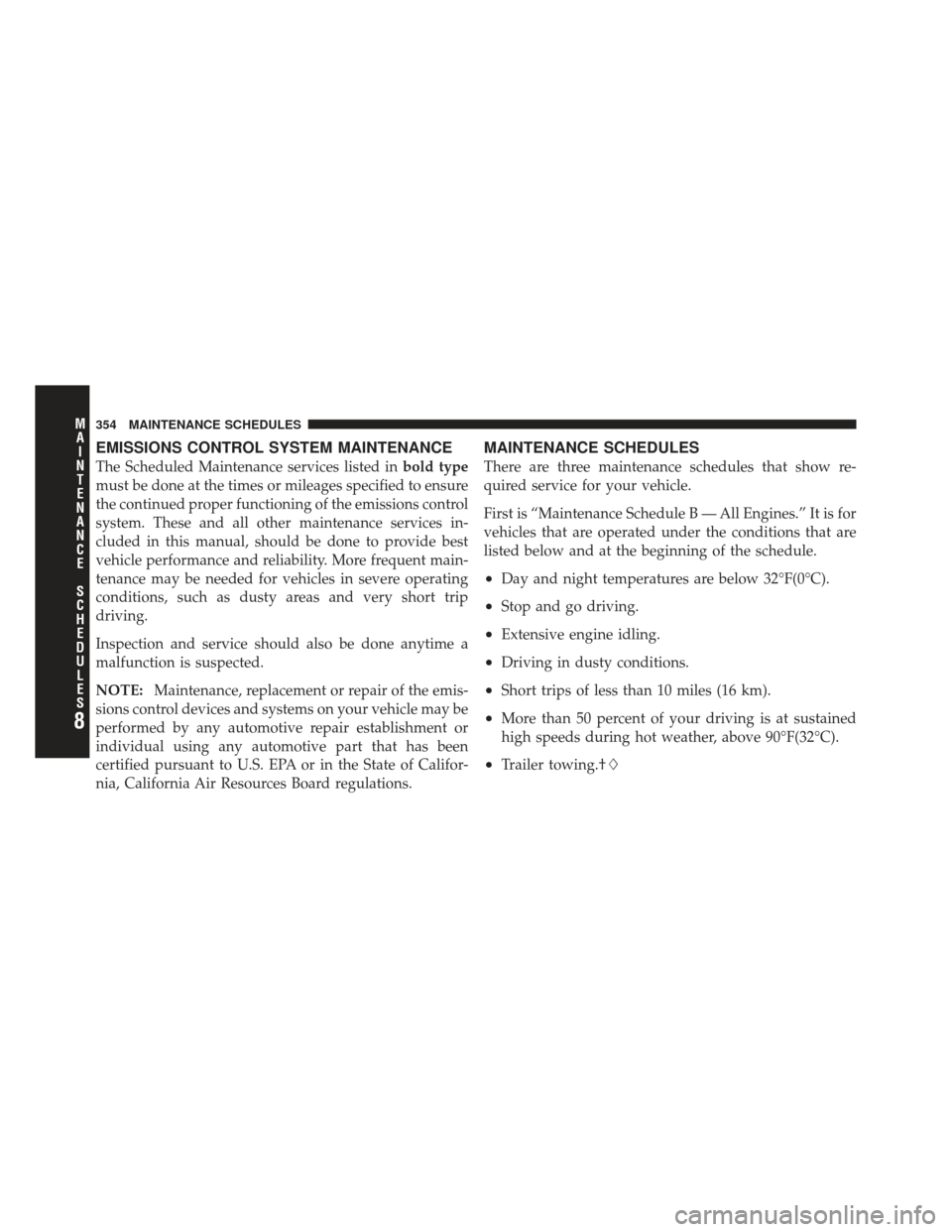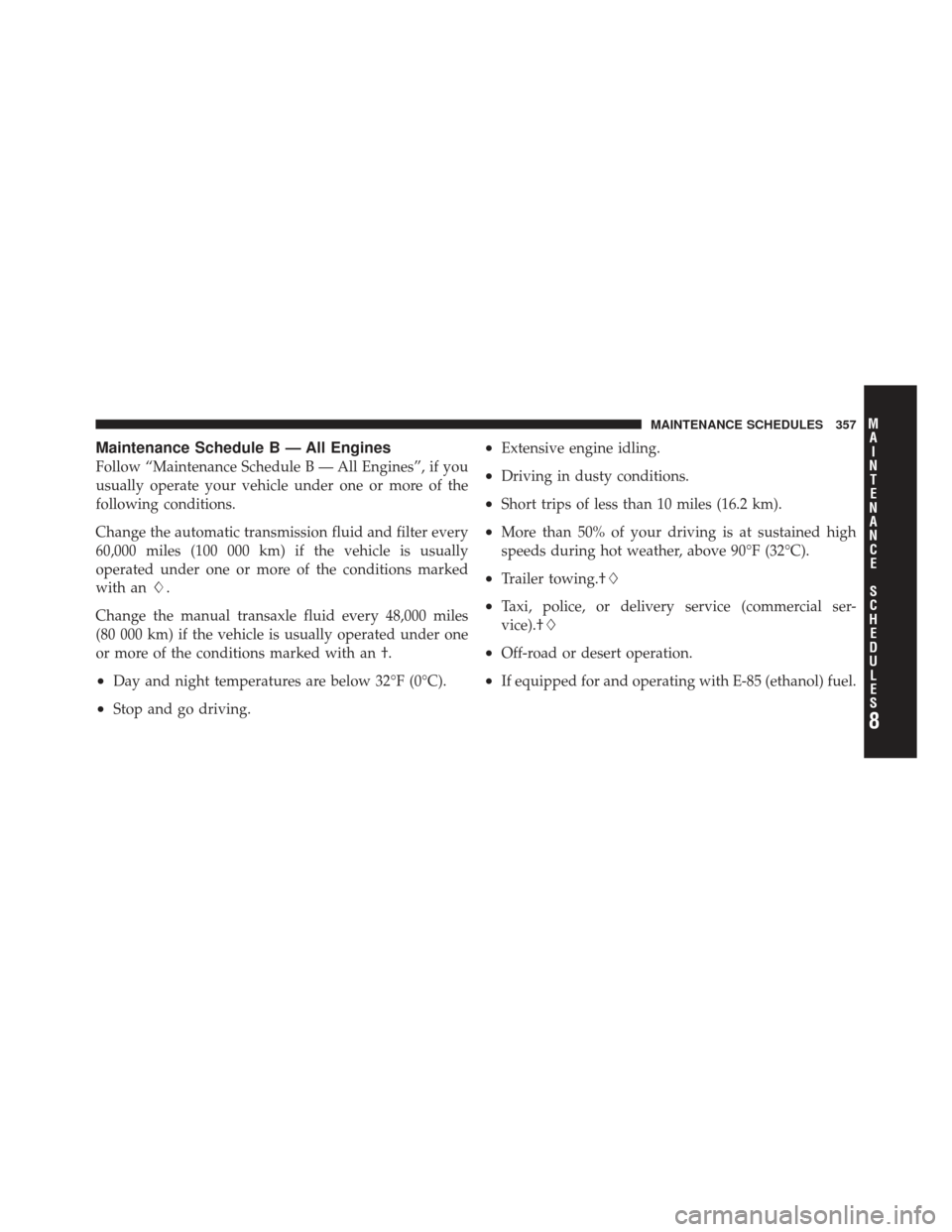Page 290 of 410
TOWING TIPS
Before setting out on a trip, practice turning, stopping
and backing the trailer in an area away from heavy
traffic.
Automatic Transaxle
The OVERDRIVE/DRIVE gear range can be selected
when towing. However, if frequent shifting occurs while
in this range, third gear should be selected.
Seven-Pin Connector
1 — Battery5 — Ground
2 — Backup Lamps 6 — Left Stop/Turn
3 — Right Stop/Turn 7 — Running Lamps
4 — Electric Brakes
288 STARTING AND OPERATING
Page 291 of 410
NOTE:Using the third gear range while operating the
vehicle under heavy operating conditions will improve
performance and extend transmission life by reducing
excessive shifting and heat build up. This action will also
provide better engine braking.
The automatic transmission fluid and filter should be
changed if you REGULARLY tow a trailer for more than
45 minutes of continuous operation. Refer to the “Main-
tenance Schedule” in Section 8 for the proper mainte-
nance intervals.
NOTE: Check the automatic transmission fluid level
before towing.Electronic Speed Control — If Equipped
•
Do not use in hilly terrain or with heavy loads.
•When using the speed control, if you experience speed
drops greater than 10 mph (16 km/h), disengage until
you can get back to cruising speed.
•Use speed control in flat terrain and with light loads to
maximize fuel efficiency.
5
STARTING AND OPERATING 289
Page 315 of 410

The best time to check the engine oil level is about five
minutes after a fully warmed engine is shut off. Do not
check oil level before starting the engine after it has sat
overnight. Checking engine oil level when the engine is
cold will give you an incorrect reading.
Checking the oil while the vehicle is on level ground, will
improve the accuracy of the oil level readings. Maintain
the oil level between the MIN and MAX markings on the
dipstick. Adding one quart of oil when the reading is at
the MIN mark will result in a MAX reading on these
engines.
CAUTION!
Overfilling the crankcase as indicated by an oil level
above the “MAX” mark on the engine oil dipstick
will cause oil aeration, which can lead to loss of oil
pressure and an increase in oil temperature. This
could damage your engine.
Change Engine Oil
Road conditions and your kind of driving affects the
interval at which your oil should be changed. Check the
following list to decide if any apply to you.
•Day and night temperatures are below 32°F (0°C).
•Stop and go driving.
•Extensive engine idling.
•Driving in dusty conditions.
•Short trips of less than 10 miles (16 km).
•More than 50% of your driving is at sustained high
speeds during hot weather, above 90°F (32°C).
•Trailer towing.
•Taxi, Police, or delivery service (commercial service).
•Off-road or desert operation.
7
MAINTAINING YOUR VEHICLE 313
Page 335 of 410

Fluid and Filter Changes
Automatic transmission fluid and filter should be
changed as follows:
Maintenance Schedule A — Non Turbocharged Engines
— No change necessary.
Maintenance Schedule A — Turbocharged Engines—
No change necessary.
Maintenance Schedule B — All Engines — Every
60,000 miles (100 000 km) change fluid and filter under
the following conditions:
•Police, taxi, limousine, commercial type operation, or
trailer towing where the vehicle is driven regularlyfor
more than 45 minutes of continuous operation.
Refer to the “Maintenance Schedules” in Section 8 for the
proper maintenance intervals.
Special Additives
Automatic Transmission Fluid (ATF) is an engineered
product and its performance may be impaired by supple-
mental additives. Therefore, do not add any fluid addi-
tives to the transaxle. The only exception to this policy is
the use of special dyes to aid in detecting fluid leaks. In
addition, avoid using transmission sealers as they may
adversely affect seals.
CAUTION!
Do not use chemical flushes in your transaxle as the
chemicals can damage your transaxle components.
Such damage is not covered by the New Vehicle
Limited Warranty.
7
MAINTAINING YOUR VEHICLE 333
Page 343 of 410
CavityCartridge
Fuse Mini-Fuse Description
3 10 Amp Red CHMSL
Brake
Switch Feed
4 10 Amp Red Ignition
Switch Feed
5 20 Amp
YellowTrailer Tow
6 10 Amp Red IOD Sw/
Pwr Mir/
Ocm
Steering
Cntrl Sdar/
Hfm
7 30 Amp
GreenIOD Sense1
8 30 Amp
GreenIOD Sense2Cavity
Cartridge
Fuse Mini-Fuse Description
9 40 Amp
Green Power Seats
10 20 Amp
YellowCCN Feed,
Power
Locks
11 15 Amp Lt
Blue Power
Outlet
12 20 Amp
YellowIgn Run/
Acc Inverter
13 20 Amp
YellowPwr Run/
Acc Outlet
RR
14 10 Amp Red IOD CCN/
Interior
Lighting
7
MAINTAINING YOUR VEHICLE 341
Page 356 of 410

EMISSIONS CONTROL SYSTEM MAINTENANCE
The Scheduled Maintenance services listed inbold type
must be done at the times or mileages specified to ensure
the continued proper functioning of the emissions control
system. These and all other maintenance services in-
cluded in this manual, should be done to provide best
vehicle performance and reliability. More frequent main-
tenance may be needed for vehicles in severe operating
conditions, such as dusty areas and very short trip
driving.
Inspection and service should also be done anytime a
malfunction is suspected.
NOTE: Maintenance, replacement or repair of the emis-
sions control devices and systems on your vehicle may be
performed by any automotive repair establishment or
individual using any automotive part that has been
certified pursuant to U.S. EPA or in the State of Califor-
nia, California Air Resources Board regulations.
MAINTENANCE SCHEDULES
There are three maintenance schedules that show re-
quired service for your vehicle.
First is “Maintenance Schedule B — All Engines.” It is for
vehicles that are operated under the conditions that are
listed below and at the beginning of the schedule.
•Day and night temperatures are below 32°F(0°C).
•Stop and go driving.
•Extensive engine idling.
•Driving in dusty conditions.
•Short trips of less than 10 miles (16 km).
•More than 50 percent of your driving is at sustained
high speeds during hot weather, above 90°F(32°C).
•Trailer towing.†
8
M A I
N T
E
N A
N CE
S
C
H E
D
U L
E
S354 MAINTENANCE SCHEDULES
Page 359 of 410

Maintenance Schedule B — All Engines
Follow “Maintenance Schedule B — All Engines”, if you
usually operate your vehicle under one or more of the
following conditions.
Change the automatic transmission fluid and filter every
60,000 miles (100 000 km) if the vehicle is usually
operated under one or more of the conditions marked
with an .
Change the manual transaxle fluid every 48,000 miles
(80 000 km) if the vehicle is usually operated under one
or more of the conditions marked with an †.
•Day and night temperatures are below 32°F (0°C).
•Stop and go driving.
•Extensive engine idling.
•Driving in dusty conditions.
•Short trips of less than 10 miles (16.2 km).
•More than 50% of your driving is at sustained high
speeds during hot weather, above 90°F (32°C).
•Trailer towing.†
•Taxi, police, or delivery service (commercial ser-
vice).†
•Off-road or desert operation.
•If equipped for and operating with E-85 (ethanol) fuel.
8
M A I
N T
E
N A
N CE
S
C
H E
D
U L
E
SMAINTENANCE SCHEDULES 357
Page 363 of 410
Miles39,000 42,000 45,000 48,000 51,000 54,000
(Kilometers) (65 000) (70 000) (75 000) (80 000) (85 000) (90 000)
Change engine oil and engine oil filter, if not
replaced at three months. XXXXX X
Rotate tires. XX X
Inspect the brake linings. X
Change the brake fluid. If vehicle is used for
trailer towing. X
Inspect the engine air cleaner filter, replace as
necessary.* X
Change the manual transaxle fluid.† X
Inspect the make-up air filter, replace as
necessary.* X
8
M
A I
N T
E
N A
N CE
S
C
H E
D
U L
E
SMAINTENANCE SCHEDULES 361